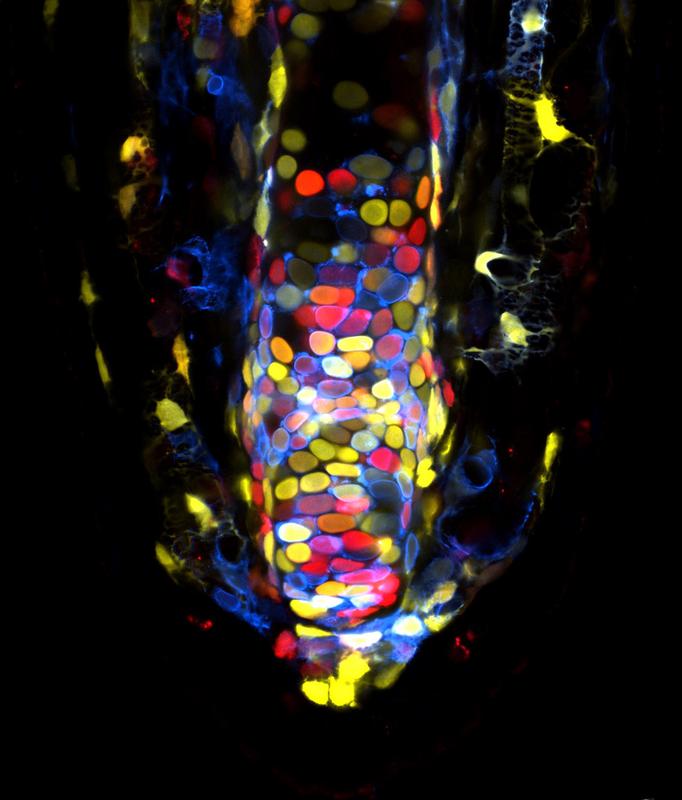Research team at the CRTD identifies cells that form new bone during Axolotl finger regeneration

Brainbow Labeling © Joshua Currie, CRTD
The axolotl is a champion of regeneration, with the ability to completely regenerate the limb skeleton and heal wounds without forming scars. Understanding how this process happens holds promise to improve the outcome of bone regeneration after fracture as well reduce scaring during wound healing.
After amputation of the axolotl limb, cells are recruited to the site of injury and build a mass of cells, called the blastema, which will build the lost portions of the limb. An outstanding question has been “Where exactly do the cells for the blastema come from?”
Using a multi-color labeling technique and live imaging of regeneration in the axolotl fingertip, Currie et al. found that cells surrounding the bone and cells beneath the skin move into the wound site to build the lost skeleton of the fingertip.
Finally, the team identified a growth factor, PDGF-BB (Platelet-derived growth factor BB), that was essential for activating cells to migrate to the site of injury and form the regenerative blastema.
“In the future it will be important to understand how PDGF-BB, a growth factor also found in humans, is able to activate cells to migrate and if human wounds could benefit from treatment with PDGF-BB to recruit more cells to aid in regeneration and scar free healing,” says the study’s first author, Joshua Currie, PhD.
Since 2011, Joshua Currie, PhD, has worked as a Postdoctoral Fellow at the CRTD. In 2011 he completed his Doctor of Philosophy at the University of North Carolina (Chapel Hill, North Carolina, USA). Before, he worked as a Research Assistant at Vanderbilt University (Nashville, Tennessee, USA).
Elly Tanaka, PhD, Professor of Animal Models of Regeneration at the Technische Universität Dresden, in the DFG Research Center, Cluster of Excellence for Regenerative Therapies (CRTD) from 2008-2016. Since September 2016, Senior Scientist at the Research Institute of Molecular Pathology (IMP) in Vienna, Austria.
Publication:
“Live Imaging of Axolotl Digit Regeneration Reveals Spatiotemporal Choreography of Diverse Connective Tissue Progenitor Pools”
DOI: http://dx.doi.org/10.1016/j.devcel.2016.10.013
Related publications:
Prayag Murawala, Elly M. Tanaka, Joshua D. Currie. ”Regeneration: The Ultimate Example of Wound Healing,” Seminars in Cell and Developmental Biology, 23(9), 954-962, 2012.
Tanaka EM. The Molecular and Cellular Choreography of Appendage Regeneration. Cell. 2016 Jun 16;165(7):1598-608. DOI: 10.1016/j.cell.2016.05.038.
Press Contact:
Franziska Clauß, M.A.
Press Officer
Phone: +49 351 458 82065
E-Mail: franziska.clauss@crt-dresden.de
Media Contact
All latest news from the category: Life Sciences and Chemistry
Articles and reports from the Life Sciences and chemistry area deal with applied and basic research into modern biology, chemistry and human medicine.
Valuable information can be found on a range of life sciences fields including bacteriology, biochemistry, bionics, bioinformatics, biophysics, biotechnology, genetics, geobotany, human biology, marine biology, microbiology, molecular biology, cellular biology, zoology, bioinorganic chemistry, microchemistry and environmental chemistry.
Newest articles

Webb captures top of iconic horsehead nebula in unprecedented detail
NASA’s James Webb Space Telescope has captured the sharpest infrared images to date of a zoomed-in portion of one of the most distinctive objects in our skies, the Horsehead Nebula….

Cost-effective, high-capacity, and cyclable lithium-ion battery cathodes
Charge-recharge cycling of lithium-superrich iron oxide, a cost-effective and high-capacity cathode for new-generation lithium-ion batteries, can be greatly improved by doping with readily available mineral elements. The energy capacity and…

Novel genetic plant regeneration approach
…without the application of phytohormones. Researchers develop a novel plant regeneration approach by modulating the expression of genes that control plant cell differentiation. For ages now, plants have been the…





















